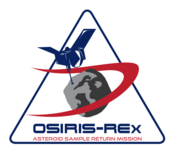OSIRIS-REx
NASA sample return mission, launched in 2016
OSIRIS-REx (Origins, Spectral Interpretation, Resource Identification, Security, Regolith Explorer) was a NASA asteroid-study and sample-return mission.[10]
 Artist's rendering of the OSIRIS-REx spacecraft | |||||||||||||||
| Names | Origins, Spectral Interpretation, Resource Identification, Security, Regolith Explorer; New Frontiers 3 | ||||||||||||||
|---|---|---|---|---|---|---|---|---|---|---|---|---|---|---|---|
| Mission type | Asteroid sample return[1] | ||||||||||||||
| Operator | NASA / Lockheed Martin | ||||||||||||||
| COSPAR ID | 2016-055A | ||||||||||||||
| SATCAT no. | 41757 | ||||||||||||||
| Website | asteroidmission.org | ||||||||||||||
| Mission duration | 7 years (planned) 889 days at asteroid (actual) 7 years, 7 months, 16 days (elapsed) | ||||||||||||||
| Spacecraft properties | |||||||||||||||
| Manufacturer | Lockheed Martin | ||||||||||||||
| Launch mass | 2,110 kg (4,650 lb)[2] | ||||||||||||||
| Dry mass | 880 kg (1,940 lb)[2] | ||||||||||||||
| Dimensions | 2.44 × 2.44 × 3.15 m (8 ft 0 in × 8 ft 0 in × 10 ft 4 in)[2] | ||||||||||||||
| Power | 1226 to 3000 W[2] | ||||||||||||||
| Start of mission | |||||||||||||||
| Launch date | 8 September 2016, 23:05 UTC[3] | ||||||||||||||
| Rocket | Atlas V 411, AV-067[3] | ||||||||||||||
| Launch site | Cape Canaveral, SLC-41 | ||||||||||||||
| Contractor | United Launch Alliance | ||||||||||||||
| End of mission | |||||||||||||||
| Landing date | 24 September 2023, 14:52 UTC[4] | ||||||||||||||
| Landing site | Utah Test and Training Range[4] | ||||||||||||||
| Orbital parameters | |||||||||||||||
| Reference system | Bennu-centric | ||||||||||||||
| Altitude | 0.68–2.1 km (0.42–1.30 mi)[5][6] | ||||||||||||||
| Period | 22–62 hours[7][6] | ||||||||||||||
| Flyby of Earth | |||||||||||||||
| Closest approach | 22 September 2017[2][8] | ||||||||||||||
| Distance | 17,237 km (10,711 mi)[8] | ||||||||||||||
| Bennu orbiter | |||||||||||||||
| Orbital insertion | 31 December 2018[9] (Rendezvous: 3 December 2018) | ||||||||||||||
| Orbital departure | 3 March 2021 (planned)[2] | ||||||||||||||
| Sample mass | 60 g (2.1 oz) (planned)[4] | ||||||||||||||
| |||||||||||||||
 OSIRIS-REx mission logo New Frontiers program | |||||||||||||||
The mission collected samples from 101955 Bennu, a carbonaceous near-Earth asteroid, and returned the samples to earth in September 2023.[11]
The material returned is expected to enable scientists to learn more about the formation and evolution of the Solar System, its initial stages of planet formation, and the source of organic compounds that led to the formation of life on Earth.[12]
OSIRIS-REx is the first United States spacecraft to return samples from an asteroid.
References
🔥 Top keywords: Main PageSpecial:Search0Slash (punctuation)BlackSpecial:RecentChanges4 (number)DavidSOLID (object-oriented design)Wikipedia:AboutFile:Sexual intercourse with internal ejaculation.webmHelp:ContentsHelp:IntroductionLisa Sparxxx2023 UEFA Champions League FinalColour24-hour clockAdolf Hitler UunonaBismillahir Rahmanir Raheem6 (number)T. N. SeshanFile:ASCII-Table-wide.svg20 (number)Poor Things (movie)United StatesCristiano RonaldoList of people who have walked on the MoonAli Malikov50 (number)17 (number)The Valley (2024 TV series)GrassList of mathematical symbolsList of U.S. states and territories by time zone8 (number)List of countries by areaWikipedia:Simple talkList of largest Hindu templesRama